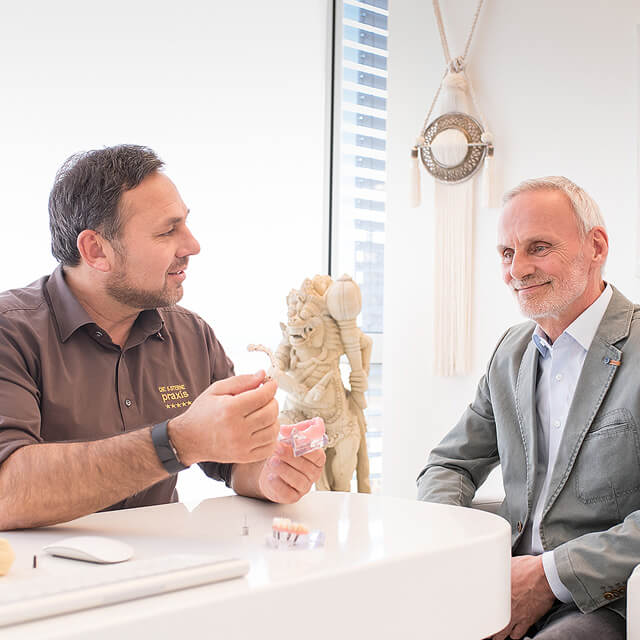Tooth Preservation – Root Canal Treatment and Fillings
Root Canal Treatment
If one tooth is loose, inflamed, or has already even died, it must be treated immediately and as a matter of urgency. If harmful bacteria enter the canals in the tooth root, they cause painful inflammations there. Also accidents in which a part of the tooth is lost can make treating the tooth root necessary.
Root Canal Treatment instead of Prosthesis
Where teeth like this ‘standing in pus’ simply used to be extracted in years gone by, nowadays we try our best to preserve even severely damaged or inflamed teeth by means of root canal treatment using special instruments in order to lose as little healthy tooth substance as possible and so that you keep your teeth in your mouth as long as possible.
Many people are anxious or scared of root canal treatment, or cannot imagine exactly what happens during it. We would like to moderate your fear of the dentist by informing you fully.
Fitting the Crown after Cleaning
With root canal treatments, first of all the diseased nerve of the tooth is removed and the root canal is prepared, cleaned and disinfected. Following this, the cavity must be sealed with a root filling that keeps bacteria out in order to prevent a renewed inflammation. And finally a crown is put in place, so that the tooth can accept normal loads again just like a strong, natural tooth.
To facilitate this, we work with the most modern instruments, such as nickel-titanium files and electronic root canal preparation devices, as well as technically highly developed magnifying spectacles and one of the latest generations of endomicroscopes for enlargement and a better depiction of the canal lumen, which is the cavity within the root canal.
Fillings
If caries has attacked a tooth, the damaged substance of the tooth must be replaced with a filling. In doing so, we should only ever remove as little of the healthy tooth as possible and only as much as is necessary.
A Suitable Filling for Every Hole
The decision on which material is used to return the tooth to its former full state depends on the size of the hole, on the position of the tooth, and on the forces which act on this tooth. Therefore, allow yourself to be advised personally and individually in a consultation.
In general, we distinguish between two types of fillings:
- Indirectly manufactured fillings (in the dental laboratory) which are manufactured from an impression. These usually consist of gold or ceramic material and are also described as inlays.
- Directly manufactured plastic fillings (in the dentist’s chair), consisting of plastics or plastic ceramics.
Say “Goodbye” to Amalgam
Would you like to finally get rid of your old amalgam fillings? On request and following an extensive examination, we can offer amalgam removal (an amalgam-free treatment concept). For this, we first of all remove the old amalgam fillings and after cleaning we replace them using a new filling material.
Using a rubber sheet, a ‘dental dam’ which is laid over the mouth, thus protecting against amalgam particles, we can guarantee a dry treatment process with absolutely no damage occurring.
A Tip from Dr. Gal
“No scalpels, no heavy bleeding and fast wound healing – lasers make this possible.”





